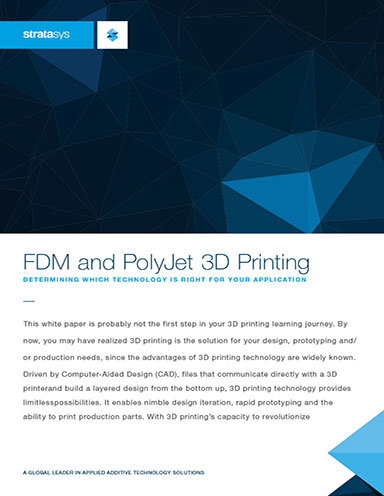
November 1, 2018
This white paper is probably not the first step in your 3D printing learning journey. By now, you may have realized 3D printing is the solution for your design, prototyping and/or production needs, since the advantages of 3D printing technology are widely known.
Driven by Computer-Aided Design (CAD), files that communicate directly with a 3D printerand build a layered design from the bottom up, 3D printing technology provides limitless possibilities. It enables nimble design iteration, rapid prototyping and the ability to print production parts. With 3D printing’s capacity to revolutionize industries, disrupt supply chains and lead medical innovation, it’s no surprise the additive technology has been described as the Third Industrial Revolution.
The right 3D technology depends on the materials, aesthetics, mechanical properties and overall performance your product requires. You may have already ruled out 3D printing technologies, such as Selective Laser Sintering (SLS), Direct Metal Laser Sintering (DMLS) and other processes, to arrive at plastics as a material solution. Of course, that still leaves the choice of Fused Deposition Modeling® (FDM), or PolyJet™ technology, two of the most advanced and versatile additive manufacturing (AM) or 3D printing technologies available. This white paper provides a detailed comparison of Fused Deposition Modeling (FDM) and PolyJet technologies and their applications within different industries.
There is some crossover in FDM and PolyJet 3D printer applications, but for the most part these two technology platforms remain distinct and offer different benefits to the user. Understanding the two technologies and their application potential for your product needs is the key to their successful application within your business. Additionally, the range of available printers goes from budgetfriendly, desktop models to large-for at, factoryfloor equipment and produce precise, finely detailed models to durable production goods.
Being fully informed about printer capabilities and output, and matching a printer process and material to your needs is the foundation to the successful application of 3D printing within your business.
Fill out the information below to download the resource.
Latest News







